Biblical Basis for Burning:
"Through
the wrath of the LORD of hosts is the land darkened, and the people shall
be as the fuel of the fire: no man shall spare
his brother."
– Isaiah 9.19.
"If a man abide
not in me, he is cast forth as a branch, and is withered; and men gather
them, and cast them into the fire, and they
are burned"
– John 15.6.
Legal basis for murder by the State
"According to the apostolic teaching and the doctrine of the Gospel, let us believe in the one deity of the Father, the Son and the Holy Spirit, in equal majesty and in a holy Trinity.
We authorize the followers of this law to assume the title of Catholic Christians; but as for the others, since, in our judgment they are foolish madmen, we decree that they shall be branded with the ignominious name of heretics, and shall not presume to give to their conventicles the name of churches.
They will suffer in the first place the chastisement of the divine condemnation and in the second the punishment of our authority which in accordance with the will of Heaven we shall decide to inflict.
Given in Thessalonica on the third day from the calends of March, during the fifth consulate of Gratian Augustus and the first of Theodosius Augustus."
– Codex Theodosianus, xvi.1.2 (380 AD)
– Penal religious laws of the 4th century
Guide Book for Torturers
"All sects of heretics
are condemned and various punishments are appointed for them and their
accomplices."
--Pope Alexander IV (1254-61)
(Directory for the Inquisitors p. 135)
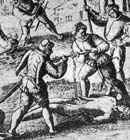
Gutted. Remarkably,
the victim's soul was undamaged by this procedure
Loving Your Neighbour? – Killing
Your Opponents!
"The list of religious atrocities committed in the sacrosanct name of Christ is long and varied ...
In proof of this, witness the gibbets, the wheels, the massacres, and the horrible burnings at the stake of nearly a hundred thousand human beings in a single province -
the massacres and devastations of nine mad crusades of Christians against unoffending Turks, during nearly two hundred years; in which many millions of human beings perished-
the massacre of the Anabaptists-
the massacres of the Lutherans and Papists, from the Rhine to the extremities of the north-
the massacres in Ireland, England, and Scotland, in the time of Charles the First, who was himself massacred-
the massacres ordered by Henry the Eighth and his daughter Mary-
the massacres of St. Bartholomew in France; and forty years more of other massacres between the time of Francis the First, and the entry of Henry the Fourth into Paris-
the massacres of the Inquisition, which are more execrable still, as being judicially committed-
to say nothing of the innumerable schisms, and twenty wars of popes against popes-bishops against bishops the poisoning assassinations-
the cruel rapines of more than a dozen of popes, who far exceeded a Nero or Caligula in every species of crime and wickedness-
the massacre of twelve millions of the inhabitants of the new world, executed CRUCIFIX IN HAND; and all for the honour and glory of the Jewish deity and his son!"
– Mitchell Logan, Christian Mythology Unveiled, 1842.
Just a
few of the tortures that 'heretics' went through:
• Skin
flayed from head, face and body
• Noses, nipples and breasts pulled off with red hot pinchers
• Fried or boiled alive or roasted on a spit
• Mouth slit back to ears
• Crucified upside down
• Thrown from windows on to spears
• Arms cut off
• Torturous slow burning, soles of feet, then up to ankles,
mid-calf, etc.
• Women stripped, hung from trees by their hair and scourged or
left hanging by one leg until dead
• Tourniquet placed on head and twisted until eyes came out
• Ears bored out
• Tongue cut out
• Set down (by pulley) into a fire by degrees
• Thrown to dogs
• Hung up by the heels and choked with smoke
• Disembowelled
• Sharp instruments forced under nails and into other body parts
• Racked until their bowels broke out
• Throats cut with butcher knives
• Knocked on the head with axes
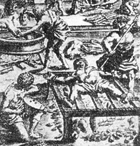
Grilled. Simple but effective
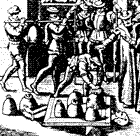
Crushed. Squeezing heresy out of the foolish
Torture Chambers
' For 1500 hundred years,
the Christian Church systematically operated torture chambers throughout
Europe. Torture was the rule, not the exception. Next to the Bible, the
most influential and venerated book in Christian history was the Malleus
Maleficarum (Hammer of Witches), which was a step-by-step tutorial in
how to torture "witches' and "sorcerers".
David Mills (Science Shams
& Bible Bloopers, p361)
Read the best-selling horror for yourself: Malleus
Maleficarum
|
|
Christians
get a lot of mileage out of the aphorism of 'turning the other
cheek', a sentiment originating at least as early as Pythagoras
in the fifth century BC. Yet both in theory and in practice,
Christians have honoured the principle of murdering their opponents.
The word, it seems, came from the very top. Apparently Jesus
himself said:
"But
those mine enemies, which would not that I should reign over
them, bring hither, and slay them before me." – Luke 19.27
(Not the word of the Lord? Oh yes it is!)
The Christian
Heaven may have been a vain folly but the Christian Hell was real
enough. For more than a thousand years sadists in the uniform of
Christ terrorised and brutalised a continent and then exported
that terror to the four corners of the globe.
The Church, which,
with a satanic twist of humour, claimed to be the instrument of 'Christ's
loving kindness' , taught a brutalised and impoverished people
new meanings to the words pain and suffering...
For those who dared
to be different:
Incarceration – starvation –
psychological torment and terror –
laceration – mutilation – strangulation – suffocation – crushing – choking
– burning –
garrotting – slow and agonizing death.
Welcome
to a Christian Europe!
|
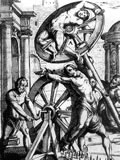 |
Breaking
on the Wheel
The naked heretic had each limb and joint broken precisely to avoid any
fatal blows. He was then 'braided' into the spokes of the wheel and hoisted
on to a post. There he was exposed to the elements – or left to
be twirled by passers by who wanted to join in the fun.
|
| |
|
The Pope's
Pears
The vaginal pear was used on woman who had sex with the Devil or his
familiars. The rectal pear was used on passive male homosexuals and the
oral pear was used on heretical preachers or lay persons found guilty
of unorthodox practices. Inserted into the mouth, anus or vagina of the
victim, the pear was expanded by use of the screw until the insides are
ripped, stretched and mutilated, almost always causing death. The pointed
ends of the 'leaves' were good for ripping the throat, intestines or
cervix open. |
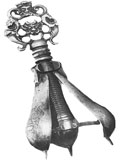
|
| |
|
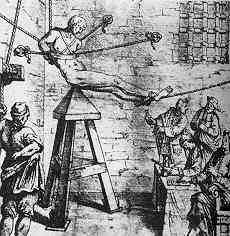 |
The Judas
Cradle
The victim is raised up by the rope or chain and then lowered until the
vagina, anus or the coccyx rests on the point. The torturer could vary
the pressure by hanging weights from the victim or rocking or raising
and dropping the victim from various heights.
|
| |
|
|
Iron
Spider
The iron would usually be heated to red-hot and then used to slowly rip
the breasts from the body. It would be used for such crimes as heresy,
adultery, self-induced abortions, blasphemy and other "hideous" crimes. |
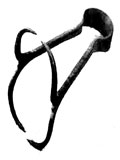
|
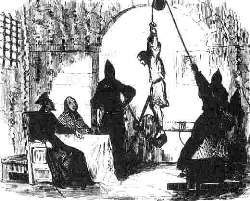 |
Strapado
Designed to dislocate the shoulders of a victim by hoisting him off the
ground, allowing him to fall, and stopping him suddenly before he touched
the ground. To add to the torment, weights (varying from 50 to 500 pounds)
were tied to the victim's body to dislocate a greater number of bones.
|
| |
|
|
|
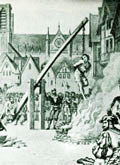
|
Cat's
Paw
A clawed rake, used to
rip the person's flesh and tear the flesh from the bones of any
part of his or her body.
|
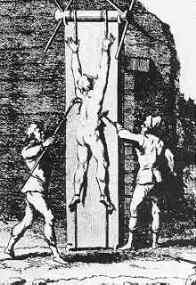 |
| |
|
Slow
Burn
This pivoted pole was a 16th century device calculated
to lift the victim in and out of the fire, roasting him alive slowly
instead of burning him all at once.
|
|
Quick Burn in Holland
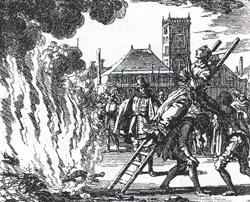 |
|

|
Extreme
Makeover
The rack – everybody's
favourite. Well, perhaps only of Inquisitors for whom
it was the instrument of choice after the pulley had failed.
For the helpless victim dislocation of every joint in the body
and elongations up to 12" were possible. 'Surgeons' might
reset joints to allow the torture to be repeated. Severe lacerations
and loss of blood would result from racking even without the
additional use of red hot pincers to tear off nipples, tongues,
ears, noses, and genitals.
A sadist's banquet – and
of course it brought the wretched heretics closer to God.
|
.jpg)
|
|
The
Holy Trinity
When a sinner had 'blasphemed the holy name of god',
or when he had perhaps told some truth about the local priest,
it was customary to apply the holy trinity.
The Iron mask was heated
in an open fire until red hot, then put upon his head. The scourge,
also red hot, was then applied to his back. After the mask had
cooled, it was removed from the sinner, taking skin (and usually
eyeballs) with it. The prisoner's mouth was then opened and red
hot pincers were used to remove the prisoner's tongue.
It is interesting
to note that the Holy Trinity was designed not to cause death,
so that the maimed, blinded and
mute prisoner could
live out his days as a burden to his family and as a testimony
to what happens when one lets his tongue wag too freely.
|
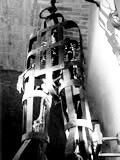
|
Luke
19.27 Not the word of the
Lord? Oh yes it is!
Christian apologists squirm and wriggle over this infamous command
of Jesus to murder his enemies. "It's not Jesus," they
say, "It's the 'harsh master' in the parable." But
is it?
Luke builds to JC's big finish in Jerusalem
by having his meandering hero tell a series of parables along the
way. Luke 19 is the link from Jericho to the Temple itself.
In verses 1-10, near Jericho, the godman invites himself into the
house of a dwarfish publican called Zacchaeus and rewards the guy
with salvation after Zac' says he is going to give half his goods
to the poor.
At verse 11 a
new scene is set: JC is about to depart (and of
course he knows crucifixion awaits him); his audience think the Kingdom
of God is at hand.
JC
responds with the infamous parable, which is actually an attempt
by 2nd century gospel writers to deal with issues raised by
the "delayed
kingdom". The believing brethren have the "good news" but
what are they to do with it?
The parable
starts with the words "A
certain man of noble birth went far to receive a kingdom. And he
called
his
ten servants, and delivered them ten pounds." Is this
JC? The answer is to be found in an earlier version
of the same yarn – in Matthew:
"For the
Kingdom of Heaven is as a man travelling into a far country,
who called his own servants, and delivered
unto them his goods." – 25,14
Matthew tells
his version of the story using just 3 servants (they represent
the Christian brethren, "servants of the Lord'). "After
a long time the Lord of those servants cometh" (25.19).
There is a reckoning (the Day of Judgement). The lord
is well pleased with 2 of them who have successfully "earned
interest on his money."
"Well done,
thou good and faithful servant: thou hast been faithful over
a few things, I will make thee ruler over
many things: enter thou into the joy of thy Lord." –
25,21.
The third servant however, who denounces his lord as harsh, says
he was "afraid" and simply hid the lord's investment.
A displeased lord turns on him as a "wicked and
slothful servant" (25:27).
The point of the story? This is how Matthew rounds it
off:
"For unto
every one that hath shall be given, and he shall have abundance:
but from him that hath not shall be
taken away even that which he hath.
And cast ye the unprofitable servant into outer darkness:
there shall be weeping and gnashing of teeth." – 25.29,30.
In other words
this so-called Parable of the Harsh Master / Parable
of the Talents is a story about what Christians are to do
with the "gospel" as they wait for the coming of the
Kingdom of Heaven. They are to spread the word ("grow the
Lord's money"), not hide it away. Correctly understood,
this is the parable of the slothful servant, threatened with "outer
darkness."
When Luke copied Matthew's efforts
he added a new element: "reluctant citizens" of the
new kingdom (no doubt he had in mind recalcitrant pagans).
"But his citizens hated him, and sent a message after him, saying, We will
not have this man to reign over us." – 19.14.
Luke followed
closely Matthew's story
but replaced the final bit threatening "outer darkness" to
lazy brethren with a more immediate and tangible injunction aimed
at "enemies":
"I tell
you, that to every one who has will more be given; but from
him who has not, even what he has will be taken
away.
But those mine
enemies, which would not that I should reign over them, bring
hither, and slay them before me." – 19.27.
Where did Luke
get his inspiration? A nobleman "travelling far to receive
a kingdom" is a rare enough event. Josephus's Antiquities
of the Jews - Book 17, chapter 11 maps the story and also provides
all the ingredients for both 19.14 and 19.27.
With the death
of Herod the Great, his son Archelaus – of noble birth – journeyed to
Rome to "receive his kingdom" from Emperor
Augustus. But at the same time an
embassy of the Jews petitioned Caesar that "out
of their hatred to him" Archelaus not "be set
over their kingdom".
Archelaus had slaughtered 3000 of his enemies at the Temple. The
emperor eventually removed him and sent him into exile in 6
AD.
Josephus
wrote Antiquities
of the Jews around 93 AD so whoever "Luke" really was, he was certainly writing his fable later than that.
top
|
Sources:
Alan Hall, The History of the Papacy (PRC, 1998)
Alice K. Turner, The History of Hell (Robert Hale, 1995)
Brian P. Levack, The Witch-Hunt in Early Modern Europe ((Longman, 1995)
A.F. Ide, The Popes... (AAP, 1987)
George Scott, A History of Torture (Senate, 1995)
Helen Ellerbe, The Dark Side of Christian History (Morningstar & Lark,
1995)
The Medieval Crime Museum Rothenburg (Video) |
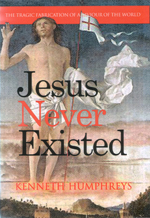
|
 |

|

|
Some fifty articles are now available as a book.
For your copy order:

|
|
Copyright © 2004
by Kenneth Humphreys.
Copying is freely permitted and there are no merchant service fees, provided credit is given to the author and
no material herein is sold for profit.
|






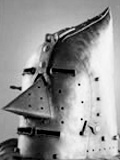







.jpg)


